小学英语语法详解疑问句--反义疑问句
- 格式:docx
- 大小:14.59 KB
- 文档页数:3
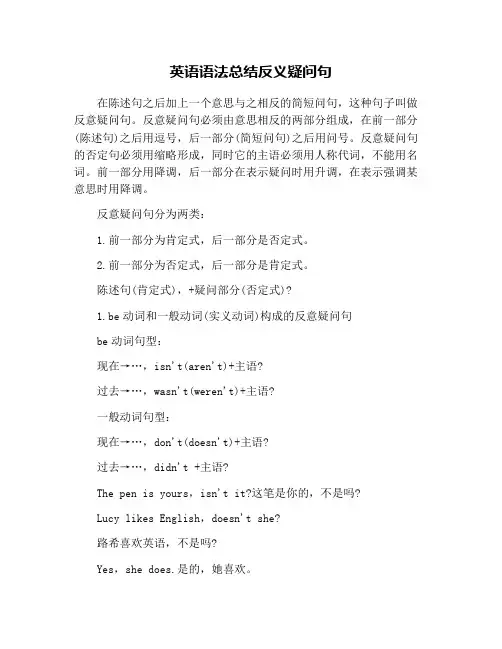
英语语法总结反义疑问句在陈述句之后加上一个意思与之相反的简短问句,这种句子叫做反意疑问句。
反意疑问句必须由意思相反的两部分组成,在前一部分(陈述句)之后用逗号,后一部分(简短问句)之后用问号。
反意疑问句的否定句必须用缩略形成,同时它的主语必须用人称代词,不能用名词。
前一部分用降调,后一部分在表示疑问时用升调,在表示强调某意思时用降调。
反意疑问句分为两类:1.前一部分为肯定式,后一部分是否定式。
2.前一部分为否定式,后一部分是肯定式。
陈述句(肯定式),+疑问部分(否定式)?1.be动词和一般动词(实义动词)构成的反意疑问句be动词句型:现在→…,isn't(aren't)+主语?过去→…,wasn't(weren't)+主语?一般动词句型:现在→…,don't(doesn't)+主语?过去→…,didn't +主语?The pen is yours,isn't it?这笔是你的,不是吗?Lucy likes English,doesn't she?路希喜欢英语,不是吗?Yes,she does.是的,她喜欢。
No,she doesn't.不,她不喜欢。
That was a wonderful night,wasn't it?那是个奇妙的夜晚,不是吗?Yes,it was.是的,它是。
No,it wasn't.不,它不是。
Your sister helped him,didn't she?你姐姐协助了他,不是吗?Yes,she did.是的。
她协助他。
No,she didn't.不。
她没有协助他。
注意反意疑问句中,前后两部分的动词在人称、数和时态上通常保持一致。
另外后一部分的人称代词应和前一部分的主语(名词或代词)保持一致。
Tom is skating,isn't he?(实行时)汤姆在滑冰,不是吗?Yes,he is.是的。
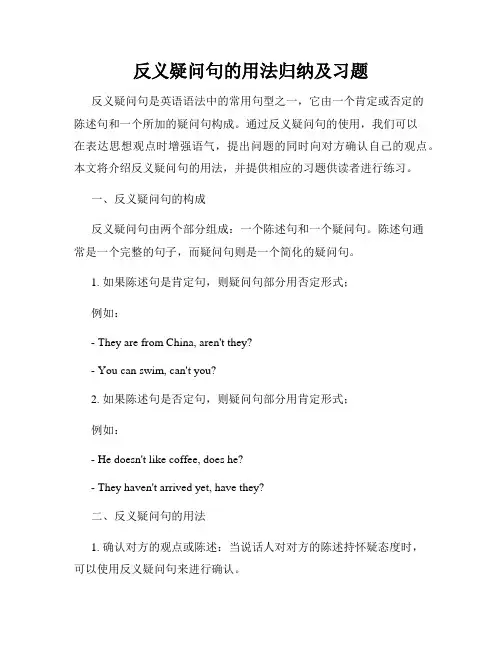
反义疑问句的用法归纳及习题反义疑问句是英语语法中的常用句型之一,它由一个肯定或否定的陈述句和一个所加的疑问句构成。
通过反义疑问句的使用,我们可以在表达思想观点时增强语气,提出问题的同时向对方确认自己的观点。
本文将介绍反义疑问句的用法,并提供相应的习题供读者进行练习。
一、反义疑问句的构成反义疑问句由两个部分组成:一个陈述句和一个疑问句。
陈述句通常是一个完整的句子,而疑问句则是一个简化的疑问句。
1. 如果陈述句是肯定句,则疑问句部分用否定形式;例如:- They are from China, aren't they?- You can swim, can't you?2. 如果陈述句是否定句,则疑问句部分用肯定形式;例如:- He doesn't like coffee, does he?- They haven't arrived yet, have they?二、反义疑问句的用法1. 确认对方的观点或陈述:当说话人对对方的陈述持怀疑态度时,可以使用反义疑问句来进行确认。
例如:- You haven't seen the movie, have you?- You don't like ice cream, do you?2. 请求对方的帮助或征求对方的意见:当说话人需要对方给予回应或意见时,可以使用反义疑问句来婉转地提出请求。
例如:- It's a beautiful day, isn't it? (期待对方赞同这个说法)- This problem is difficult, isn't it? (希望对方给予帮助或建议)3. 表达自己的观点或感受:反义疑问句也可以用来表达自己的观点或感受,并期待对方与自己保持一致或不一致。
例如:- She is a talented singer, isn't she?- You're not feeling well, are you?三、习题练习以下是一些习题,供读者练习反义疑问句的用法。
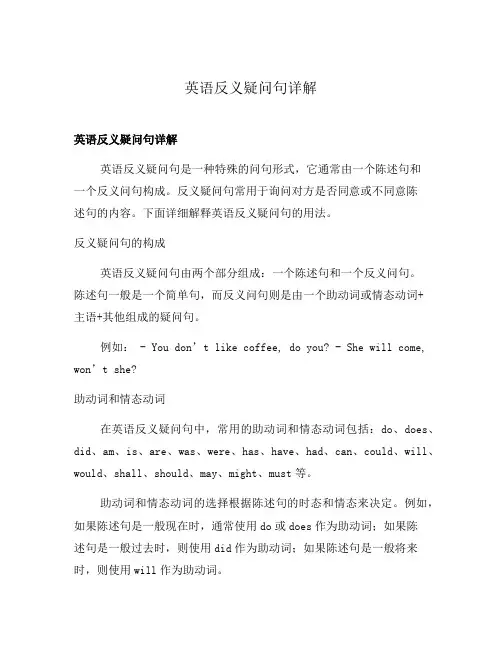
英语反义疑问句详解英语反义疑问句详解英语反义疑问句是一种特殊的问句形式,它通常由一个陈述句和一个反义问句构成。
反义疑问句常用于询问对方是否同意或不同意陈述句的内容。
下面详细解释英语反义疑问句的用法。
反义疑问句的构成英语反义疑问句由两个部分组成:一个陈述句和一个反义问句。
陈述句一般是一个简单句,而反义问句则是由一个助动词或情态动词+主语+其他组成的疑问句。
例如: - You don’t like coffee, do you? - She will come, won’t she?助动词和情态动词在英语反义疑问句中,常用的助动词和情态动词包括:do、does、did、am、is、are、was、were、has、have、had、can、could、will、would、shall、should、may、might、must等。
助动词和情态动词的选择根据陈述句的时态和情态来决定。
例如,如果陈述句是一般现在时,通常使用do或does作为助动词;如果陈述句是一般过去时,则使用did作为助动词;如果陈述句是一般将来时,则使用will作为助动词。
主语和其他反义疑问句中的主语和其他成分与陈述句保持一致。
如果陈述句的主语是第一人称(I)、第二人称(you)或不具体的第三人称(everyone、nothing等),则在反义问句中保持不变。
如果陈述句的主语是第三人称具体的名词或代词,则在反义问句中使用相应的人称代词。
例如: - She likes ice cream, doesn’t she? - They don’t have a car, do they?疑问部分的调整在英语反义疑问句中,疑问部分的词序通常与一般疑问句相同,即助动词或情态动词在主语之前。
但是,如果陈述句中已经包含了助动词或情态动词,疑问部分只需省略即可。
例如: - She is reading a book, isn’t she? - They can’t swim, can they?对陈述句的确认或否定英语反义疑问句常用于对陈述句的内容进行确认或否定。
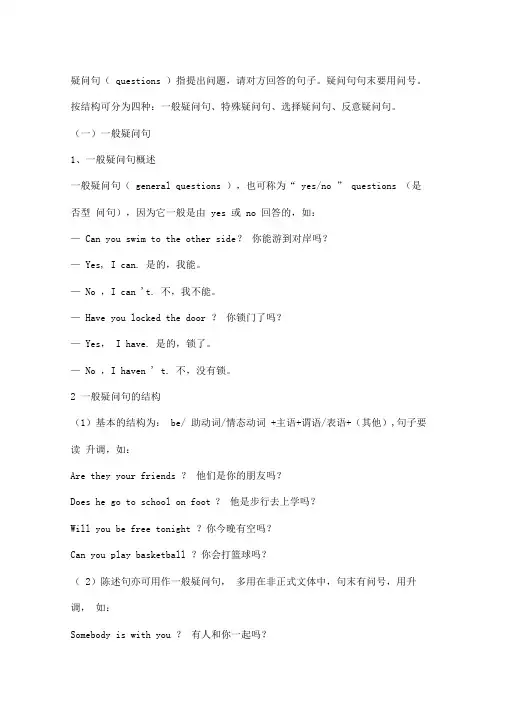
疑问句( questions )指提出问题,请对方回答的句子。
疑问句句末要用问号。
按结构可分为四种:一般疑问句、特殊疑问句、选择疑问句、反意疑问句。
(一)一般疑问句1、一般疑问句概述一般疑问句( general questions ),也可称为“ yes/no ” questions (是否型问句),因为它一般是由 yes 或 no 回答的,如:— Can you swim to the other side ?你能游到对岸吗?— Yes, I can. 是的,我能。
— No ,I can 't. 不,我不能。
— Have you locked the door ?你锁门了吗?— Yes, I have. 是的,锁了。
— No ,I haven ' t. 不,没有锁。
2 一般疑问句的结构(1)基本的结构为: be/ 助动词/情态动词 +主语+谓语/表语+(其他),句子要读升调,如:Are they your friends ?他们是你的朋友吗?Does he go to school on foot ?他是步行去上学吗?Will you be free tonight ?你今晚有空吗?Can you play basketball ?你会打篮球吗?( 2)陈述句亦可用作一般疑问句,多用在非正式文体中,句末有问号,用升调,如:Somebody is with you ?有人和你一起吗?He didn ' t finish the work ?他没有做完活吗?You are fresh from America , I suppose ?我猜,你刚从美国回来吧?3、一般疑问句的答语( 1)一般疑问句一般由 yes 或 no 来回答,如:— Are you tired ?你累了吗?— Yes,I am. 是的 ,累了。
— No, I ' m not. 不,不累。
— Does she do the cleaning ?她扫除了吗?— Yes , she does. 是的,她打扫了。
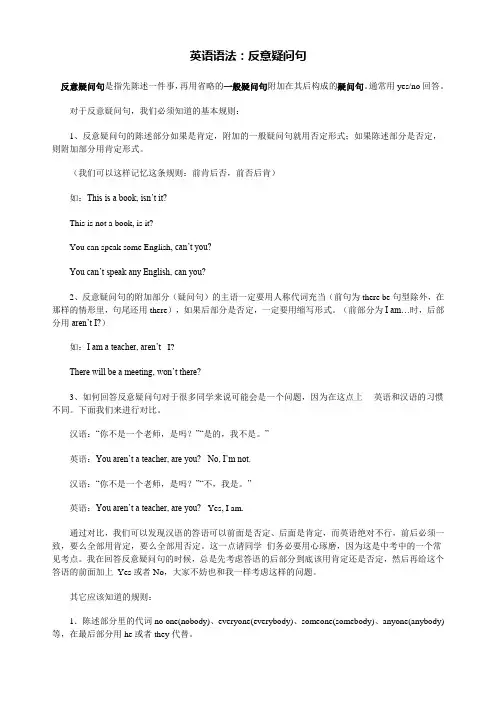
英语语法:反意疑问句反意疑问句是指先陈述一件事,再用省略的一般疑问句附加在其后构成的疑问句。
通常用yes/no回答。
对于反意疑问句,我们必须知道的基本规则:1、反意疑问句的陈述部分如果是肯定,附加的一般疑问句就用否定形式;如果陈述部分是否定,则附加部分用肯定形式。
(我们可以这样记忆这条规则:前肯后否,前否后肯)如:This is a book, isn’t it?This is not a book, is it?You can speak some English, can’t you?You can’t speak any English, can you?2、反意疑问句的附加部分(疑问句)的主语一定要用人称代词充当(前句为there be句型除外,在那样的情形里,句尾还用there),如果后部分是否定,一定要用缩写形式。
(前部分为I am…时,后部分用aren’t I?)如:I am a teacher, aren’t I?There will be a meeting, won’t there?3、如何回答反意疑问句对于很多同学来说可能会是一个问题,因为在这点上英语和汉语的习惯不同。
下面我们来进行对比。
汉语:“你不是一个老师,是吗?”“是的,我不是。
”英语:You aren’t a teacher, are you?No, I’m not.汉语:“你不是一个老师,是吗?”“不,我是。
”英语:You aren’t a teacher, are you?Yes, I am.通过对比,我们可以发现汉语的答语可以前面是否定、后面是肯定,而英语绝对不行,前后必须一致,要么全部用肯定,要么全部用否定。
这一点请同学们务必要用心琢磨,因为这是中考中的一个常见考点。
我在回答反意疑问句的时候,总是先考虑答语的后部分到底该用肯定还是否定,然后再给这个答语的前面加上Yes或者No,大家不妨也和我一样考虑这样的问题。
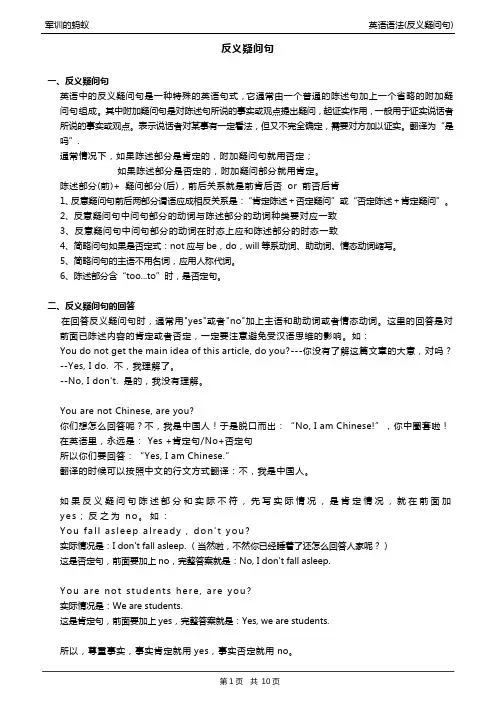
反义疑问句一、反义疑问句英语中的反义疑问句是一种特殊的英语句式,它通常由一个普通的陈述句加上一个省略的附加疑问句组成。
其中附加疑问句是对陈述句所说的事实或观点提出疑问,起证实作用,一般用于证实说话者所说的事实或观点。
表示说话者对某事有一定看法,但又不完全确定,需要对方加以证实。
翻译为“是吗”.通常情况下,如果陈述部分是肯定的,附加疑问句就用否定;如果陈述部分是否定的,附加疑问部分就用肯定。
陈述部分(前)+ 疑问部分(后),前后关系就是前肯后否or 前否后肯1、反意疑问句前后两部分谓语应成相反关系是:“肯定陈述+否定疑问”或“否定陈述+肯定疑问”。
2、反意疑问句中问句部分的动词与陈述部分的动词种类要对应一致3、反意疑问句中问句部分的动词在时态上应和陈述部分的时态一致4、简略问句如果是否定式:not应与be,do,will等系动词、助动词、情态动词缩写。
5、简略问句的主语不用名词,应用人称代词。
6、陈述部分含“too...to”时,是否定句。
二、反义疑问句的回答在回答反义疑问句时,通常用"yes"或者"no"加上主语和助动词或者情态动词。
这里的回答是对前面已陈述内容的肯定或者否定,一定要注意避免受汉语思维的影响。
如:You do not get the main idea of this article, do you?---你没有了解这篇文章的大意,对吗?--Yes, I do. 不,我理解了。
--No, I don't. 是的,我没有理解。
You are not Chinese, are you?你们想怎么回答呢?不,我是中国人!于是脱口而出:“No, I am Chinese!”,你中圈套啦!在英语里,永远是: Yes +肯定句/No+否定句所以你们要回答:“Yes, I am Chinese.”翻译的时候可以按照中文的行文方式翻译:不,我是中国人。
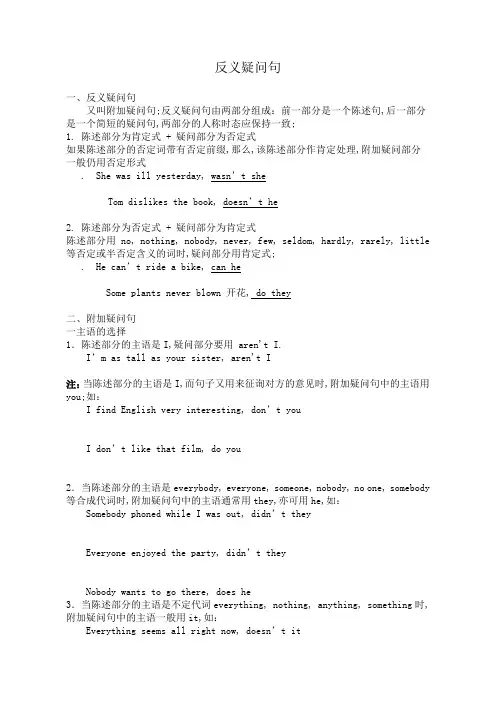
反义疑问句一、反义疑问句又叫附加疑问句;反义疑问句由两部分组成:前一部分是一个陈述句,后一部分是一个简短的疑问句,两部分的人称时态应保持一致;1.陈述部分为肯定式 + 疑问部分为否定式如果陈述部分的否定词带有否定前缀,那么,该陈述部分作肯定处理,附加疑问部分一般仍用否定形式. She was ill yesterday, wasn’t sheTom dislikes the book, doesn’t he2.陈述部分为否定式 + 疑问部分为肯定式陈述部分用 no, nothing, nobody, never, few, seldom, hardly, rarely, little 等否定或半否定含义的词时,疑问部分用肯定式;. He can’t ride a bike, can heSome plants never blown 开花, do they二、附加疑问句一主语的选择1.陈述部分的主语是I,疑问部分要用 aren't I.I’m as tall as your sister, aren't I注:当陈述部分的主语是I,而句子又用来征询对方的意见时,附加疑问句中的主语用you;如:I find English very interesting, don’t youI don’t like that film, do you2.当陈述部分的主语是everybody, everyone, someone, nobody, no one, somebody 等合成代词时,附加疑问句中的主语通常用they,亦可用he,如:Somebody phoned while I was out, didn’t theyEveryone enjoyed the party, didn’t theyNobody wants to go there, does he3.当陈述部分的主语是不定代词everything, nothing, anything, something时,附加疑问句中的主语一般用it,如:Everything seems all right now, doesn’t itNothing is kept in good order, is itSomething must be done to stop pollution, isn’t it4.当陈述部分的主语是指示代词this, that或these, those时,附加疑问句中的主语分别用it和they,如:This is important, isn’t itThat isn’t correct, is itThese are your friends Tom and Jack, aren’t they5.如果陈述部分是以代词one作主语,附加疑问句中的主语在正式场合用one,非正式场合下可以用you或he,如:One can’t be too careful, can one或can youOne should do his duty, shouldn’t he6.当陈述句为there be结构时,附加疑问句中的主语也用there;如:There’s no help for it, is thereThere’s something wrong, isn’t there7.当陈述部分为主从复合句时,附加疑问部分一般应与主句的主语和谓语动词保持对应关系;如:She says that I did it, doesn’t sheI told them not everybody could do it ,didn’t I但当陈述部分的主语是I,谓语是think, believe, suppose, expect这类动词时,附加疑问部分则往往与从句中的主语和谓语动词保持对应关系,但要注意否定的转移;I suppose that he’s serious isn’t heI don’t think she cares, does she8.当陈述部分是并列句,附加疑问句则需和就近的分句的主语和谓语一致;如:Xiao Lin has been writing letters all afternoon but he should finish them now, shouldn’t he9.在由“祈使句+附加疑问”构成的附加疑问句中,附加疑问部分的主语一般用you;如:Don’t open the door, will youGive me some cigarettes, can youTake a rest, why don’t you但以let’s开头的祈使句,附加疑问部分用shall we;以let us开头的祈使句,如果含义是allow us,不包括听话人在内,疑问部分用will you;如:Let’s have a basketball match this afternoon, shall weLet us go out for a rest, will you10.陈述句子中的主语为动词不定式短语、动名词短语或其他短语时,疑问部分的主语通常用it;如:Learning how to repair motors takes a long time, doesn’t itBetween six and seven will suit you, won’t itWhere to hold the meeting has not been decided, has it二谓语动词的选择1.当陈述部分带有情态动词must表示“必须”时,疑问部分用mustn’t;如:You must work hard next term, mustn’t youI must answer the letter, mustn’t I但若表推测这层含义时,不能用must,而要根据陈述部分的不定式结构即must之后的动词以及含义采用相应的动词形式;如:You must have made a mistake, haven’t youThey must have seen the film last week, didn’t theyHe must be in the library, isn’t he2.当陈述部分含有used to时,疑问部分可用usedn’t或didn’t;如:The old man used to smoke, didn’t /usedn’t heTom used to live here, usedn’t /didn’t he3.当陈述部分带有情态动词ought to时,疑问部分用oughtn’t或shouldn’t;如:He ought to know the answer, oughtn’t heWe ought to read this book, oughtn’t/ shouldn’t we4.当陈述部分含有情态动词dare或need时,疑问部分常用 need /dare +主语;We need not do it again, need weHe dare not say so, dare you但当dare, need 为实义动词时,疑问部分用助动词do + 主语;She doesn't dare to go home alone, does she5.当陈述部分含有had better时,疑问部分用hadn’t; 如:You’d better finish your homework now, hadn’t you6.感叹句后的附加疑问句的谓语动词需用be的现在时,且常用否定形式;如:What a clever boy, isn’t heWhat a lovely day, isn’t it7.陈述句中的谓语动词是wish,表示愿望时,附加疑问句用may,且用肯定形式;如:I wish to have a chance to learn English, may I8.当陈述部分带有表示“所有”含义的动词havehas时,疑问部分既可用have形式,也可用do形式;如:You have a new bike, haven’t you或don’t youShe doesn’t have any money in her pocket, does she9.陈述部分有have to +v. had to + v.,疑问部分常用don't +主语didn't +主语;如:We have to get there at eight tomorrow, don't we10.陈述部分有would rather +v.,疑问部分多用 wouldn't +主语;如:He would rather read it ten times than recite it, wouldn't he11.陈述部分有You'd like to +v. 疑问部分用wouldn't +主语;如:12.陈述部分由neither… nor, either… or 连接的并列主语时,疑问部分根据其实际逻辑意义而定;Neither you nor I am engineer, are we13.在口语和非正式文体中,为了加强语气,只是表示某种惊奇、怀疑、反感、讽刺等感情而并不是为了寻求回答,这时前后两部分的肯定、否定是一致的;如:Oh, he is a writer, is heYou’ll not go, won’t you三反义疑问句的回答对反意疑问句的回答,无论问题的提法如何,如果事实是肯定的,就用yes,事实是否定的,就要用no;例:—He likes playing football, doesn’t he 他喜欢踢足球,是吗—Yes, he does. / No, he doesn’t. 是的,他喜欢;/ 不是,他不喜欢;当陈述句部分是否定结构,附加疑问句部分用肯定式提问时,回答yes或no与汉语的意思正好相反;这种回答的yes要译成“不”,no要译成“是”;—His sister didn’t attend the meeting, did she 他妹妹没有参加会议,是吗—Yes, she did. / No, she didn’t. 不,她参加了;/ 是的,她没参加;反义疑问句练习1. Linda ate nothing this morning, ___A. didn’t sheB. was sheC. did sheD. wasn’t she2. There’s hardly___ milk in the bottle, _____thereA. no, isn’tB. some, isC. little, isn’tD. any, is3. He has never ridden a horse before, ___A. does heB. has heC. hasn’t heD. doesn’t he4. — He seldom came here, _____ — Yes sir.A. didn’t heB. does heC. doesn’t heD. did he5. Everything seems all right, _____A. does itB. don’t theyC. won’t itD. doesn’t itA. oneB. heC. itD. we8. No one failed in the exam, _____A. was heB. did oneC. did theyD. didn’t he10. Neither you nor I am a artist, _____A. am IB. aren’t weC. are weD. ain’t I11. He can’t be her father, _____ heA. isB. isn’tC. canD. can’t12. They have no time to visit the museum, _____A. do theyB. haven’t theyC. don’t theyD. will they14. You’d better go at once, _____ youA. hadn’tB. didC. didn’tD. don’t15. You’d rather work than play, _____ youA. hadn’tB. wouldn’tC. didn’tD. mustn’t16. You dare not do that, _____ youA. don’tB. doC. dareD.daren’t18. He dislikes the two subjects, _____ heA. doesB. doesn’tC. isD.isn’t19. These tools are useless now, _____A. are theyB. aren’t theyC. is itD. isn’t it20. He used to get up at 6:30, _____ heA. didn’t heB. did heC. used heD. wouldn’t heA. mustn’tB. oughtn’tC. shouldn’tD. Both B and C.23. Let’s go there by bus, ___A. will youB. shall weC. don’t youD. will you24. Let us go to play football, ___A. will youB. shall weC. do weD. are we25. Don’t forget to give Polly some food and change her water, ___A. will youB. shall weC. won’t youD. do you26. —Let’s go shopping this afternoon, _____ — All right.A. will weB. shall weC. don’t weD. are we27. — Pass me the dictionary, _____— Yes, with pleasure.A. would youB. will youC. won’t youD. wouldn’t you30. There is little water in the glass, ____A. isn’t thereB. isn’t itC. is itD. is there32. There won’t be any concert this Saturday evening, _____A. will there notB. will thereC. is thereD. won’t33. — I guess she taught herself Japanese, ______ — Yes.A. don’t IB. did sheC. do ID. didn’t she34. I don’t believe you are right, _____A. are youB. do youC. won’t youD. do35. She doesn’t think that Tom sings best in the class, _____A. does sheB. doesn’t sheC. does heD. doesn’t he37. I know you didn’t want to hurt me, _____A. did youB. didn’t youC. do ID. don’t I38. If my father were here, he would be very happy, _____A. weren’t heB. were heC. wouldn’t heD. would he。
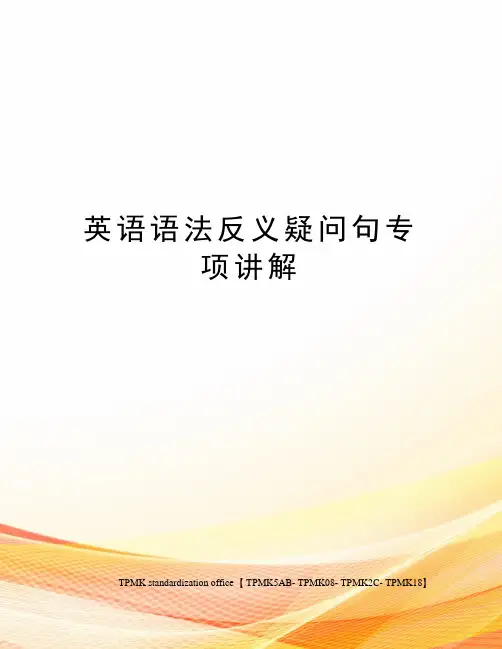
英语语法反义疑问句专项讲解TPMK standardization office【 TPMK5AB- TPMK08- TPMK2C- TPMK18】反义疑问句一、反义疑问句又叫附加疑问句。
反义疑问句由两部分组成:前一部分是一个陈述句,后一部分是一个简短的疑问句,两部分的人称时态应保持一致。
1.陈述部分为肯定式 + 疑问部分为否定式(如果陈述部分的否定词带有否定前缀,那么,该陈述部分作肯定处理,附加疑问部分一般仍用否定形式)e.g. She was ill yesterday, wasn’t sheTom dislikes the book, doesn’t he2.陈述部分为否定式 + 疑问部分为肯定式(陈述部分用 no, nothing, nobody, never, few, seldom, hardly, rarely, little等否定或半否定含义的词时,疑问部分用肯定式。
)e.g. He can’t ride a bike, can heSome plants never blown (开花), do they二、附加疑问句(一)主语的选择1.陈述部分的主语是I,疑问部分要用 aren't I.I’m as tall as your sister, aren't I?注:当陈述部分的主语是I,而句子又用来征询对方的意见时,附加疑问句中的主语用you。
如:I find English very interesting, don’t youI don’t like that film, do you2.当陈述部分的主语是everybody, everyone, someone, nobody, no one, somebody等合成代词时,附加疑问句中的主语通常用they,亦可用he,如:Somebody phoned while I was out, didn’t theyEveryone enjoyed the party, didn’t theyNobody wants to go there, does he3.当陈述部分的主语是不定代词everything, nothing, anything, something 时,附加疑问句中的主语一般用it,如:Everything seems all right now, doesn’t itNothing is kept in good order, is itSomething must be done to stop pollution, isn’t it4.当陈述部分的主语是指示代词this, that或these, those时,附加疑问句中的主语分别用it和they,如:This is important, isn’t itThat isn’t correct, is itThese are your friends Tom and Jack, aren’t they5.如果陈述部分是以代词one作主语,附加疑问句中的主语在正式场合用one,非正式场合下可以用you或he,如:One can’t be too careful, can one或can youOne should do his duty, shouldn’t he6.当陈述句为there be结构时,附加疑问句中的主语也用there。
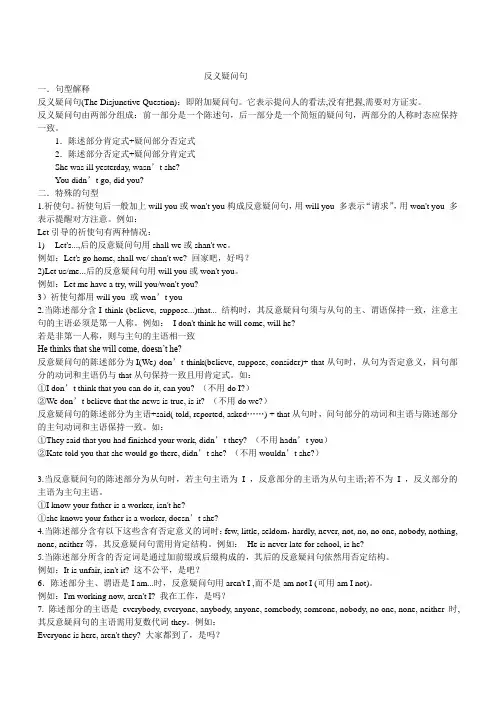
反义疑问句一.句型解释反义疑问句(The Disjunctive Question):即附加疑问句。
它表示提问人的看法,没有把握,需要对方证实。
反义疑问句由两部分组成:前一部分是一个陈述句,后一部分是一个简短的疑问句,两部分的人称时态应保持一致。
1.陈述部分肯定式+疑问部分否定式2.陈述部分否定式+疑问部分肯定式She was ill yesterday, wasn’t she?You didn’t go, did you?二.特殊的句型1.祈使句。
祈使句后一般加上will you或won't you构成反意疑问句,用will you 多表示“请求”,用won't you 多表示提醒对方注意。
例如:Let引导的祈使句有两种情况:1) Let's...,后的反意疑问句用shall we或shan't we。
例如:Let's go home, shall we/ shan't we? 回家吧,好吗?2)Let us/me...后的反意疑问句用will you或won't you。
例如:Let me have a try, will you/won't you?3)祈使句都用will you 或won’t you2.当陈述部分含I think (believe, suppose...)that... 结构时,其反意疑问句须与从句的主、谓语保持一致,注意主句的主语必须是第一人称。
例如:I don't think he will come, will he?若是非第一人称,则与主句的主语相一致He thinks that she will come, doesn’t he?反意疑问句的陈述部分为I(We) don’t think(believe, suppose, consider)+ that从句时,从句为否定意义,问句部分的动词和主语仍与that从句保持一致且用肯定式。
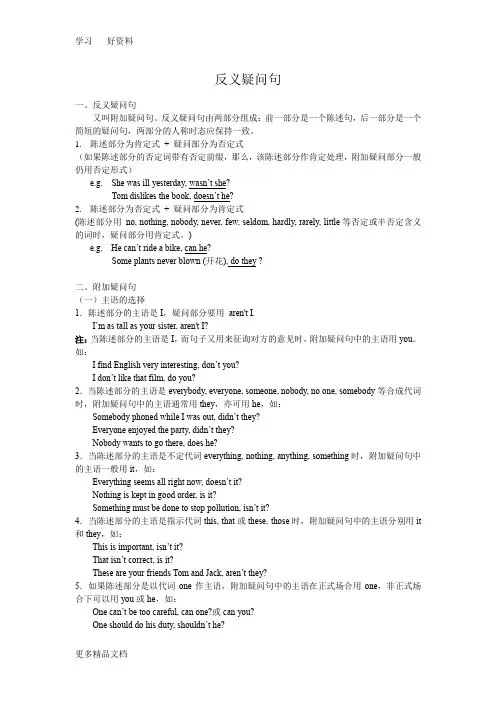
反义疑问句一、反义疑问句又叫附加疑问句。
反义疑问句由两部分组成:前一部分是一个陈述句,后一部分是一个简短的疑问句,两部分的人称时态应保持一致。
1.陈述部分为肯定式+ 疑问部分为否定式(如果陈述部分的否定词带有否定前缀,那么,该陈述部分作肯定处理,附加疑问部分一般仍用否定形式)e.g. She was ill yesterday, wasn’t she?Tom dislikes the book, doesn’t he?2.陈述部分为否定式+ 疑问部分为肯定式(陈述部分用no, nothing, nobody, never, few, seldom, hardly, rarely, little等否定或半否定含义的词时,疑问部分用肯定式。
)e.g. He can’t ride a bike, can he?Some plants never blown (开花), do they ?二、附加疑问句(一)主语的选择1.陈述部分的主语是I,疑问部分要用aren't I.I’m as tall as your sister, aren't I?注:当陈述部分的主语是I,而句子又用来征询对方的意见时,附加疑问句中的主语用you。
如:I find English very interesting, don’t you?I don’t like that film, do you?2.当陈述部分的主语是everybody, everyone, someone, nobody, no one, somebody等合成代词时,附加疑问句中的主语通常用they,亦可用he,如:Somebody phoned while I was out, didn’t they?Everyone enjoyed the party, didn’t they?Nobody wants to go there, does he?3.当陈述部分的主语是不定代词everything, nothing, anything, something时,附加疑问句中的主语一般用it,如:Everything seems all right now, doesn’t it?Nothing is kept in good order, is it?Something must be done to stop pollution, isn’t it?4.当陈述部分的主语是指示代词this, that或these, those时,附加疑问句中的主语分别用it 和they,如:This is important, isn’t it?That isn’t correct, is it?These are your friends Tom and Jack, aren’t they?5.如果陈述部分是以代词one作主语,附加疑问句中的主语在正式场合用one,非正式场合下可以用you或he,如:One can’t be too careful, can one?或can you?One should do his duty, shouldn’t he?6.当陈述句为there be结构时,附加疑问句中的主语也用there。
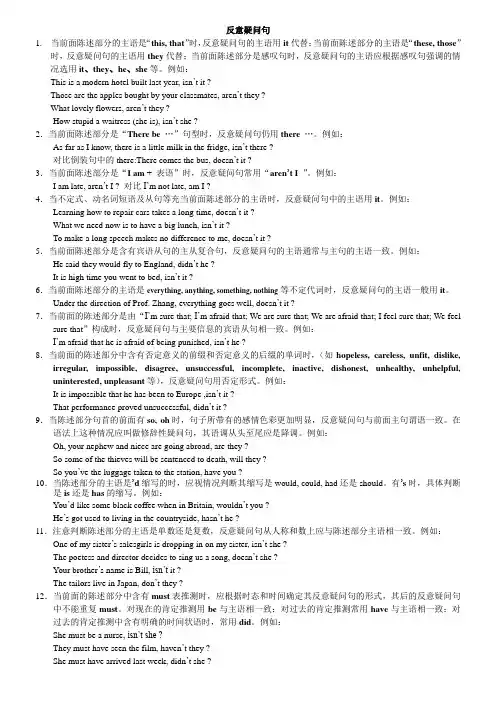
反意疑问句1.当前面陈述部分的主语是“this, that”时,反意疑问句的主语用it代替;当前面陈述部分的主语是“these, those”时,反意疑问句的主语用they代替;当前面陈述部分是感叹句时,反意疑问句的主语应根据感叹句强调的情况选用it、they、he、she等。
例如:This is a modern hotel built last year, isn’t it ?Those are the apples bought by your classmates, aren’t they ?What lovely flowers, aren’t they ?How stupid a waitress (she is), isn’t she ?2.当前面陈述部分是“There be…”句型时,反意疑问句仍用there…。
例如:As far as I know, there is a little milk in the fridge, isn’t there ?对比倒装句中的there:There comes the bus, doesn’t it ?3.当前面陈述部分是“I am + 表语”时,反意疑问句常用“aren’t I”。
例如:I am late, aren’t I ? 对比I’m not late, am I ?4.当不定式、动名词短语及从句等充当前面陈述部分的主语时,反意疑问句中的主语用it。
例如:Learning how to repair cars takes a long time, doesn’t it ?What we need now is to have a big lunch, isn’t it ?To make a long speech makes no difference to me, doesn’t it ?5.当前面陈述部分是含有宾语从句的主从复合句,反意疑问句的主语通常与主句的主语一致。
第七部分内容■反意疑问句1. 反意疑问句的疑问部分不可用人名字2. 回答以否定形式开始的反意疑间句(或一般疑问句)时,习惯上与汉语不一样3. 陈述部分用了rarely等否定词,疑问部分应该用肯定式4. 陈述部分为复合句时,疑问部分一般根据主句动调来决定用肯定式还是否定式5. 陈述部分用了must,疑问部分却不一定用6. 陈述部分有have时,疑问部分不一定用have7. 陈述部分用I am时,疑问部分用aren't I8. 以Let's开始的祈使句放前面时,后面疑问部分用shall we9. 以Don't开始的句子中,疑问部分不可用do(won't) you■请正式开始学习1. 反意疑问句的疑问部分不可用人名字。
【错例】Mary hasn't seen her brother,has Mary?【改正】改has Mary为has she.【句意】玛丽没有见到她哥哥,是吗?【解释】一般的反意疑问句要注意四点:1)陈述部分与疑问部分在人称、数、时态和体方面要一致。
2)陈述部分用肯定式、疑问部分则用否定式,或者陈述部分用否定式,疑问部分用肯定式。
3)疑问部分要用代词,不用名词,动词的否定式要用紧缩式-n't(如果不用紧缩式,则用第一助动词+主语+not) 。
如:John will help me with my English,won't he\will he not?约翰愿意帮助我学习英语,是吗?Mary didn't get bullied yesterday,did she?玛丽昨天没受欺侮吧?4) 当陈述部分的主语为somebody,anyone,no one等不定代词时,疑问部分的主语多用they,也可以用he.Everybody is here, aren’t they?No one was hurt,were they?Somebody borrowed my pen yesterday,didn't they?2. 回答以否定形式开始的反意疑问句(或一般疑问句)时,习惯上与汉语不一样。
英语四种疑问句的用法归纳疑问句是英语语法中常用的一种句型,用于提出问题或询问信息。
根据不同的情况,英语中常用四种不同的疑问句形式,分别是一般疑问句、特殊疑问句、选择疑问句和反义疑问句。
本文将对这四种疑问句的用法进行归纳总结。
一、一般疑问句一般疑问句是最常见的一种疑问句形式,其基本结构为:助动词/情态动词+主语+动词原形+其他成分。
当肯定回答时,用"Yes, 主语+助动词/情态动词";当否定回答时,用"No, 主语+助动词+not"。
例如:1. Are you going to the party tonight?2. Do they like chocolate?3. Can she speak Spanish?4. Is it raining outside?二、特殊疑问句特殊疑问句用于询问特定的事实、情况或信息,其基本结构为:疑问词+一般疑问句结构。
例如:1. Where does he live?2. What time is the meeting?3. How often do you exercise?4. Why did she quit her job?常用的特殊疑问词包括:who(谁)、what(什么)、when(什么时候)、where(在哪里)、why(为什么)、how(如何)、which (哪一个)等。
三、选择疑问句选择疑问句用于在给出多个选项时进行选择,其基本结构为:是否+助动词/情态动词+动词原形+其他成分。
例如:1. Would you like tea or coffee?2. Do you prefer the beach or the mountains?3. Will you go by car or by train?选择疑问句中常用的短语包括:or(或者)、either... or...(要么...要么...)、neither... nor...(既不...也不...)等。
反义疑问句的构成反义疑问句是英语语法中常用的一种句式结构,在交流中常用于确认对方的陈述是否正确或表达一种期望、建议等。
它由两部分组成:一个陈述句和一个反义疑问句。
本文将介绍反义疑问句的构成方式以及相关注意事项。
一、反义疑问句的构成方式反义疑问句由一个肯定或否定陈述句和一个反义疑问部分组成。
肯定陈述句后面的反义疑问部分通常以一个短语进行表示,这个短语由一个助动词和主语进行构成,助动词与陈述句的情态动词、助动词、be动词等保持一致,主语与前面的陈述句主语保持一致。
以下是一些常见的反义疑问句的构成方式:1. 肯定陈述句 + 否定的反义疑问部分:- He is an engineer, isn't he?- She has finished her homework, hasn't she?2. 否定陈述句 + 肯定的反义疑问部分:- They don't have a car, do they?- You didn't watch the movie, did you?3. 使用情态动词的陈述句:- You can swim, can't you?- They should study harder, shouldn't they?4. 使用be动词的陈述句:- He is a doctor, isn't he?- You are from France, aren't you?需要注意的是,反义疑问句的反义部分应该与前面的陈述句保持一致,如果前面使用了否定词或否定短语,反义疑问句应该采用肯定形式。
另外,反义疑问句中的助动词一般用缩写形式,如is not可缩写为isn't。
二、反义疑问句的用法反义疑问句主要用于以下几种情况:1. 确认对方的陈述是否正确:- You like ice cream, don't you?- He can speak Spanish, can't he?2. 寻求对方的确认或同意:- Let's go to the movies, shall we?- We should leave now, shouldn't we?3. 表达一种期望、建议或请求:- You will come to the party, won't you?- Please lend me your pen, will you?4. 反问加强语气:- You really think I'm beautiful, don't you?- You don't want to miss this opportunity, do you?三、其他注意事项1. 动词形式的变化:在反义疑问句中,如果陈述句中的动词是行为动词,反义疑问句的助动词应该与主语保持一致,即根据主语的人称和数的变化进行调整。
反意疑问句的构成和使用了解反意疑问句的构成和用法反意疑问句的构成和使用反意疑问句是英语语法中的一种特殊疑问句形式,通常由主句和附属句组成,在附属句中使用一个与主句中所陈述的情况相反的辅助动词或情态动词,并在附属句的末尾使用一个与主句的谓语形式相匹配的疑问词或疑问副词加以提问。
反意疑问句的构成和使用在英语日常交流中非常常见,因此对其掌握具有重要意义。
本文将介绍反意疑问句的构成和使用,帮助读者更好地理解和运用。
一、反意疑问句的构成反意疑问句由简单的主句和相应的附属句构成,附属句通常由一个否定形式的辅助动词或情态动词和一个与主句谓语形式相匹配的疑问词或疑问副词组成。
以下是几个常见的反意疑问句的构成方式:1. 副词修饰的陈述句:如果主句中有一个副词修饰,附属句使用情态动词或助动词。
例如:- He is coming, isn't he?- She can swim, can't she?2. 肯定句加否定的陈述句:如果主句中是一个肯定句,附属句使用否定的形式。
- They have seen the movie, haven't they?- She will finish her homework, won't she?3. 否定句加肯定的陈述句:如果主句中是一个否定句,附属句使用肯定的形式。
例如:- You didn't go to the party, did you?- He doesn't like ice cream, does he?二、反意疑问句的使用反意疑问句用于对于已知信息或事实进行提问,以确认说话者所陈述的事实是否正确或寻求对方的确认或补充信息。
以下是反意疑问句的常见使用情况:1. 请求确认反意疑问句常用于请求确认说话者所陈述的事实是否正确。
例如:- You are coming to the party, aren't you?(你要来参加派对,对吧?)- He can speak French, can't he?(他会说法语,不是吗?)2. 对某事情的期望反意疑问句还可表达对某件事情的期望或希望。
反意疑问句分为两类:1.前⼀部分为肯定式,后⼀部分是否定式。
2.前⼀部分为否定式,后⼀部分是肯定式。
陈述句(肯定式),+疑问部分(否定式)?1.be动词和⼀般动词(实义动词)构成的反意疑问句be动词句型:现在→…,isn't(aren't)+主语?过去→…,wasn't(weren't)+主语?⼀般动词句型:现在→…,don't(doesn't)+主语?过去→…,didn't +主语?The pen is yours,isn't it?这笔是你的,不是吗?Lucy likes English,doesn't she?路希喜欢英语,不是吗?Yes,she does.是的,她喜欢。
No,she doesn't.不,她不喜欢。
That was a wonderful night,wasn't it?那是个奇妙的夜晚,不是吗?Yes,it was.是的,它是。
No,it wasn't.不,它不是。
Your sister helped him,didn't she?你姐姐帮助了他,不是吗?Yes,she did.是的。
她帮助他。
No,she didn't.不。
她没有帮助他。
注意反意疑问句中,前后两部分的动词在⼈称、数和时态上通常保持⼀致。
另外后⼀部分的⼈称代词应和前⼀部分的主语(名词或代词)保持⼀致。
Tom is skating,isn't he?(进⾏时)汤姆在滑冰,不是吗?Yes,he is.是的。
No,he isn't.不。
She is loved by her parents,isn't she?(被动语态)她被她⽗母亲疼爱着,不是吗?Yes,she is.是的。
No,she isn't.不。
进⾏时和被动语态的反意疑问句的形式和be动词、⼀般动词的反意疑问句句型⼀样。
小学英语语法详解疑问句——反义疑问句
什么是疑问句?
疑问句是用于提出疑问的句子,可分为:一般疑问句、特殊疑问句、选择疑问句和反意疑问句。
四. 反意疑问句
反义疑问句又叫附加疑问句,是指当提问的人对前面所叙述的事实不敢肯定,而需向对方加以证实时所提出的问句。
1.反意疑问句的构成
反意疑问句的结构为:前一部分是一个陈述句,后一部分是一个简单的问句。
1)前肯定后否定式
It’s very hot outside isn’t it?外面很热,是吗?
They are good friends,aren't they??他们是好朋友,是吗?
You wll go to London,won't you?你要去伦敦,是吗?
2)前否定后肯定式
Tom won't marry her,wil he?
汤姆不打算和她结婚,是吗?
He didn't have a chance,did he?
他没有机会,是吗?
She can't understand it,can she?
她不能理解这件事,是吗?
3)其他一些情况
①There be句型中,反义疑问部分必须为be动词+ there
There are some apples in the bag,aren’t there?
袋子里有一些苹果,是吗?
There isn’t any water in the bottle,is there?
瓶子里没有水了,是吗?
②当陈述部分是祈使句时,疑问句要根据语气来表达
Give me a hand,will you?
帮我一下,好吗?
Let's go to the cinema,shall we?
我们去电影院,好吗?
Don't make any noise,can you?
不要发出噪声,好吗?
③当陈述部分有never,seldom,hardly等否定意义的词汇时,后面的反意疑问句则为肯定形式
He can hardly swim,can he?
他几乎不会游泳,是吗?
They seldom play together,do they?
他们很少在一起玩,是吗?
2.反意疑问句的回答
1)当陈述部分为肯定式,反义疑问句为否定式时,一般只需照实际情况回答即可。
It's yours,isn't it?这是你的,是吗?
Yes,it is.
是的,是我的。
或者:
No,it isn't.
不,不是我的。
He wants to go,doesn't he?
他想去,是吗?
Yes,he does.
是的,他想去。
或者:
No,he doesn't.
不,他不想去。
2)当陈述部分为否定式,其回答方式则主要根据前半句(否定句)来判断。
He hasn't arrived,has he?
他还没到,是吗?
No,he hasn’t.
是的,他还没到。
(虽然在中文解释时,我们用“是的,他还没到”更容易理解,但在英语中,必须用No。
)
或者:
Yes,he has.
不,他到了。
His sister didn't go to the party,did she?
他的姐姐没有去派对,是吗?
No,she didn't.
是的,她没有去。
或者:
Yes,she did.
不,她去了。
Linda老师的小提醒
★反意疑问句中,陈述部分的主语是“I”,疑问部分要用aren't I.
I’m as tall as your sister,aren't I?
★在反意疑问句的回答时,只要遵循几个原则一般就不会发生错误。
a.遵照实际情况
It is a fine day,isn't it?
今天是个好天,是吗?
Yes,it is.
是的。
It isn't a fine day,is it?
今天不是一个好天,是吗?
Yes,it is.
不,是个好天。
b.简短问句的时态、人称等和前半部分的陈述句要一致。
They will have a picnic in the park,won't they?
他们明天要去公园野餐,是吗?
He read a book last night,did he?
他昨晚读了一本书,是吗?。